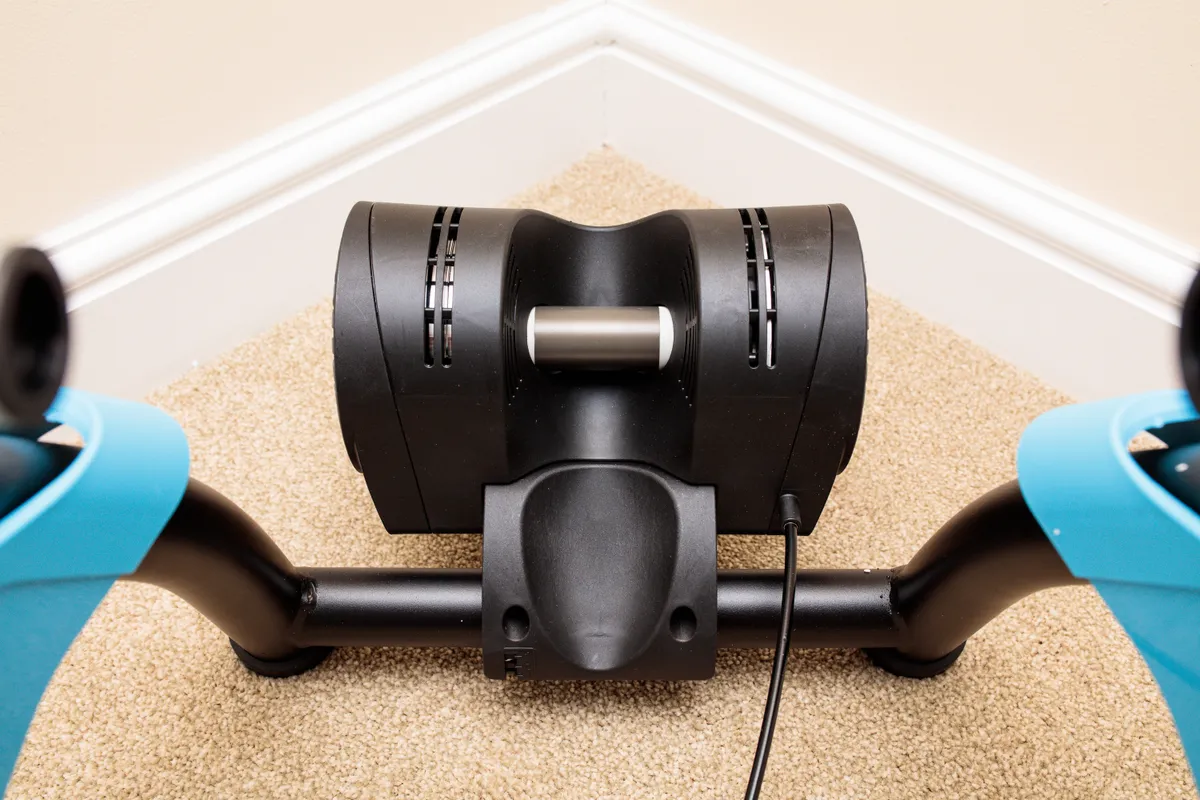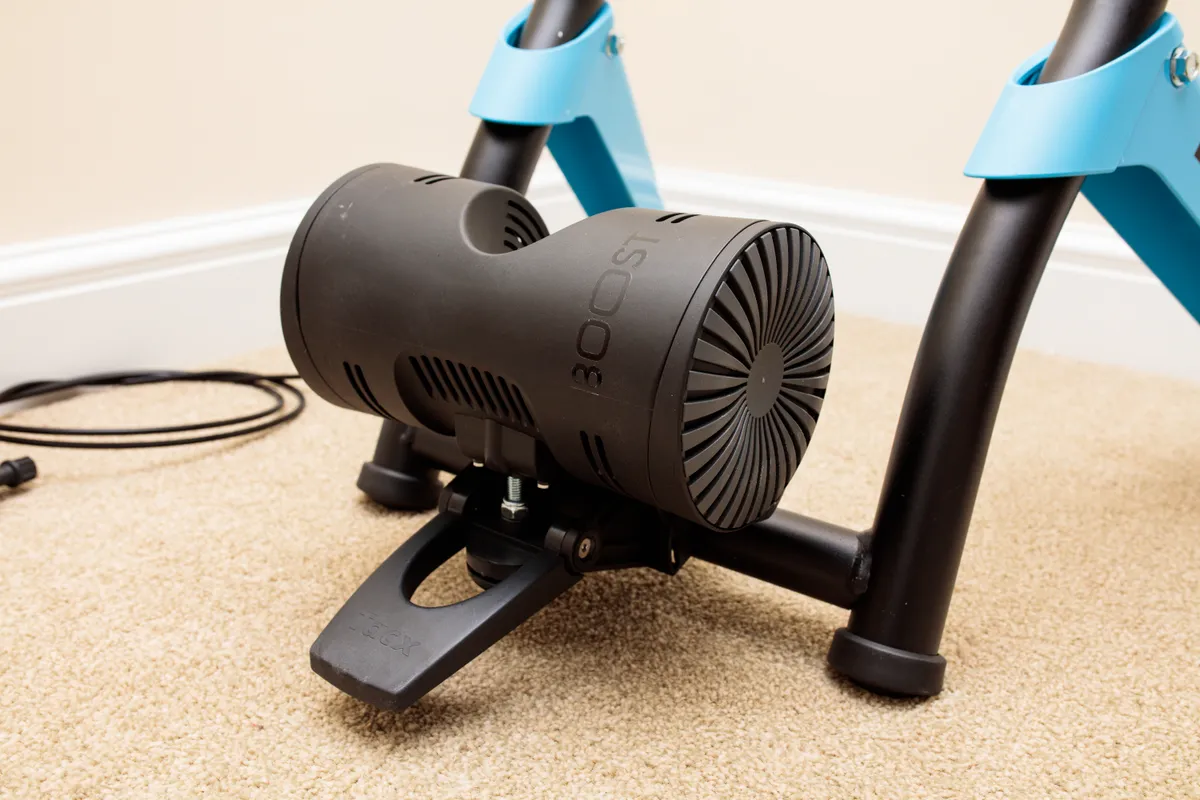The new Tacx Boost is an affordable, classic (non-smart) turbo trainer, with a 1.65kg flywheel and ten different levels of adjustable resistance.
In order to generate resistance against pedalling, the Boost uses a magnetic brake unit. Tacx claims this can provide up to 1,050 watts of pedalling resistance at an effective speed of 40kph, which is impressive for a trainer at this price point.
At an RRP of £229.99 / €249.99 / $299.99 / AU$349 or £249.99 / €279.99 / $329.99 / AU$399 for a bundle including a speed sensor (which makes it Zwift-compatible on a basic level), the Boost is situated at the more budget end of the turbo trainer market, overall.
Yet, while it’s far cheaper than the best smart trainers, it's not the most budget-friendly indoor cycling option available either.
There are even basic smart trainer options around the same price as the Boost bundle, such as Elite’s Novo Smart trainer (£259) or Tacx’s own Flow Smart trainer (£269.99), so the Boost faces stiff competition.
Unfortunately, it doesn’t quite hit the mark.
Tacx Boost setup, build and ride quality
The Boost does require a small amount of assembly out of the box, but it’s not complicated and only a single, included, Allen key is required.
A quick-release skewer is included to offer compatibility with all bikes with 5mm rear QR axles, but adaptors for bikes with thru-axles aren’t included. If you have a road or mountain bike with disc brakes, for example, you may need to purchase an adaptor separately from Tacx (prices start at €29.99).
Once assembled, folding out the legs and attaching your bike to the trainer is very simple, as is adjusting the roller pressure on the tyre. The included front wheel riser block – a useful turbo trainer accessory – also helps level the bike out nicely.
Being a dumb trainer (that is to say, not a smart trainer), it doesn’t require any mains power and once you’ve finished your session, it folds away compactly for easy storage.
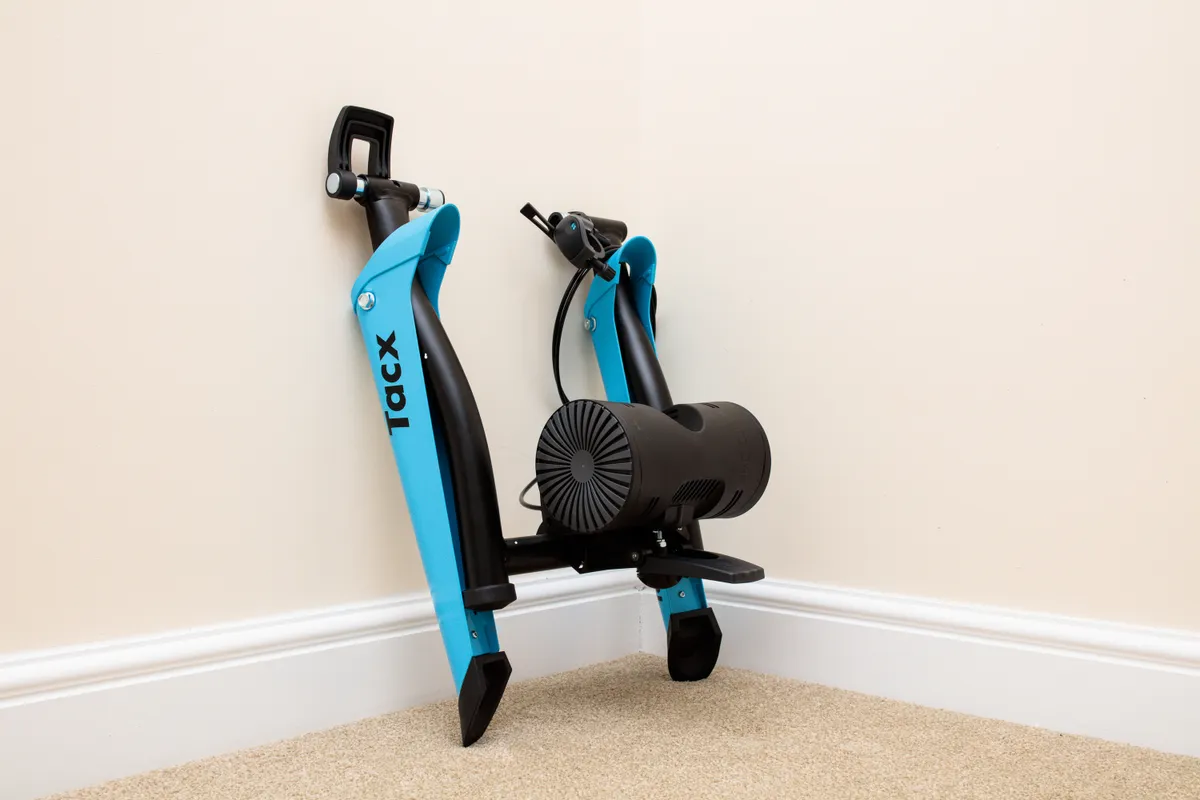
The resistance changing lever is designed to be mounted to your handlebars for easy access, but the one on my test unit arrived done up so tightly I couldn’t unscrew it to do this. This made changing the resistance during testing an awkward, two-handed job. I’ve put this to Tacx and am awaiting a response.
The build quality is generally solid overall, though the majority of the unit’s 8.54kg weight is located in the resistance unit, which is held centrally and slightly off the ground, on the rear of the Boost’s frame.
The legs, in comparison, are fairly lightweight and as a result the Boost is quite unstable side to side, and the feet of the support legs can lift off the floor when sprinting.
It also makes getting on and off the bike a bit more precarious because, as I discovered, it’s quite easy to tip the trainer and bike over (possibly taking you with it) if you put too much weight on one side of the bike and aren’t paying attention or are still clipped into a pedal.
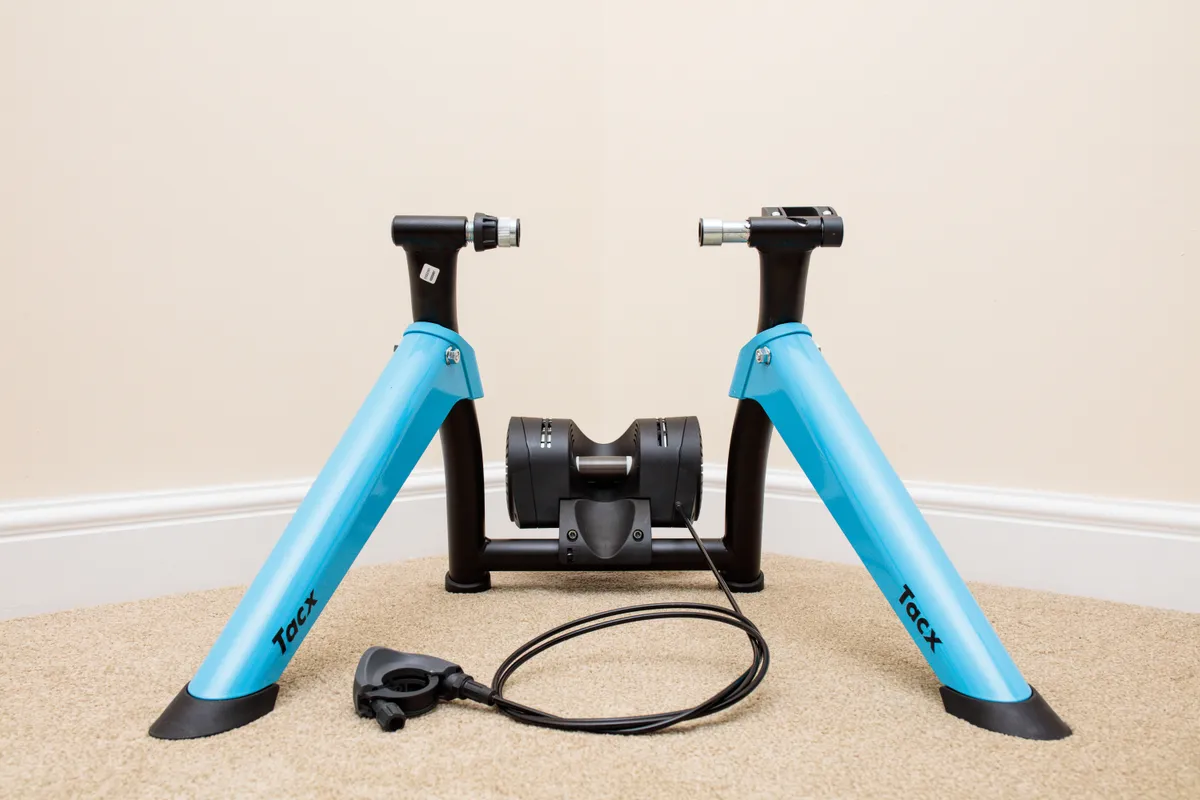
In comparison, my trusty ten or so years old Elite Crono Fluid trainer weighs more than a kilo less, at 7.48kg, but distributes its weight much more evenly towards the edges of the support legs, and is subsequently far less prone to tipping.
The ride quality is acceptable for a trainer of this price. It gets a bit choppy at the higher resistance settings – it’s not fluid through the entirety of the pedal stroke – but the flywheel generates enough inertia to make the ride feel fine, if not amazing, on all but the highest settings.
With the exception of not being able to mount it to my handlebars (as previously noted), the Boost’s resistance lever works as advertised, notching up the resistance slightly with each click. This is useful for simulating climbing or for doing high power efforts.
Personally, I find changing resistance manually a touch inconvenient. I much prefer the automatic, progressive ramping up of pedalling resistance that a fluid trainer provides.
On the other hand, being able to manually change the resistance offers a kind of climb simulation, and some might prefer that.

In terms of noise levels, the Boost is okay at lower wattages, measuring around 65 decibels at 200 watts, but it rises above 70 decibels at 300 watts – equivalent to a vacuum cleaner or hairdryer, according to Google. I saw peaks of around 80 decibels when sprinting (if you can call it that) at around 700 watts.
Those figures were recorded on an iPhone located about half a metre or so from the Boost’s resistance unit, and were enough to prompt complaints from my partner sitting downstairs.
More powerful riders than I will almost certainly experience higher peak noise levels during sprints because it’s directly related to how hard you can mash the pedals.
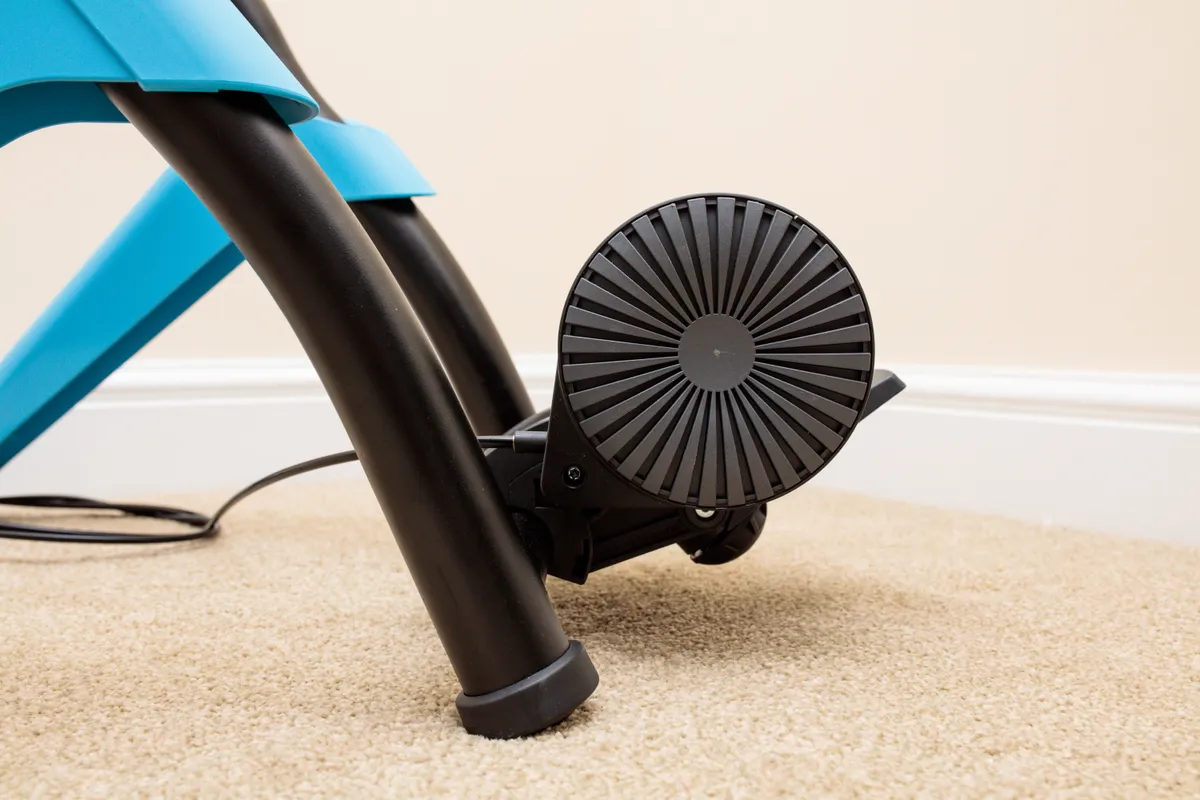
The noise levels are an improvement over the cheapest turbo trainer options on the market, but the Boost also costs more than double.
Unfortunately, even with all of the technological advancements indoor cycling has seen recently, it seems wheel-on magnetic trainers are simply still more noisy than many fluid trainers.
We noted this was an issue with Saris’s otherwise excellent M2 wheel-on smart trainer, for example. When we tested the Tacx Vortex wheel-on smart trainer in 2017, our tester (a much more powerful cyclist than me) was able to pull a whopping 90 decibels of noise from it at max power.
The Wahoo Kickr Snap smart trainer is one of the few wheel-on magnetic trainers to avoid this issue, but, at £429.99, it is significantly more expensive than the Boost.
Using the Tacx Boost on Zwift
As with other non-smart trainers, the Tacx Boost can’t natively connect to popular indoor cycling apps such as Zwift, RGT Cycling, Rouvy, The Sufferfest or Tacx’s own indoor training app.
In order to use the Boost on Zwift, for example, you’ll need an ANT or Bluetooth-compatible speed sensor, as a minimum. Unfortunately, a speed sensor isn’t included with the Tacx Boost as standard, but a bundle option with one is available for £249.99, intended to offer compatibility with apps.
With a speed sensor connected to Zwift, you can select the Tacx Booster (an older model with a very similar spec – the Boost isn’t an available option yet on Zwift) as a supported trainer to power your avatar using zPower.
This is a calculated estimate of your power output based on the known power curve (the power required to make the rear wheel on your bike spin at a certain speed, at a certain resistance setting) of a given trainer.
It’s not the best Zwift setup (and that’s reflected in its price), but it's affordable and works, to a degree.
In Zwift’s suggested resistance setting of ‘2’ – the setting for which Zwift knows the trainer’s power curve – the Boost can also only provide resistance up to around 400 watts. Fine for steady-state efforts, but no good for sprinting.
You can ignore Zwift’s recommendation and turn the resistance level of the Boost up a few notches, but doing so will decrease the accuracy of zPower.
Unsurprisingly, the accuracy of zPower didn’t match my current benchmark power meter, a set of Favero Assioma Duo power meter pedals, even in the suggested resistance setting, generally reporting high in steady states and low in sprints. However, that’s not unexpected from a trainer which fundamentally doesn’t offer power measurement – what you’re getting is an estimate.
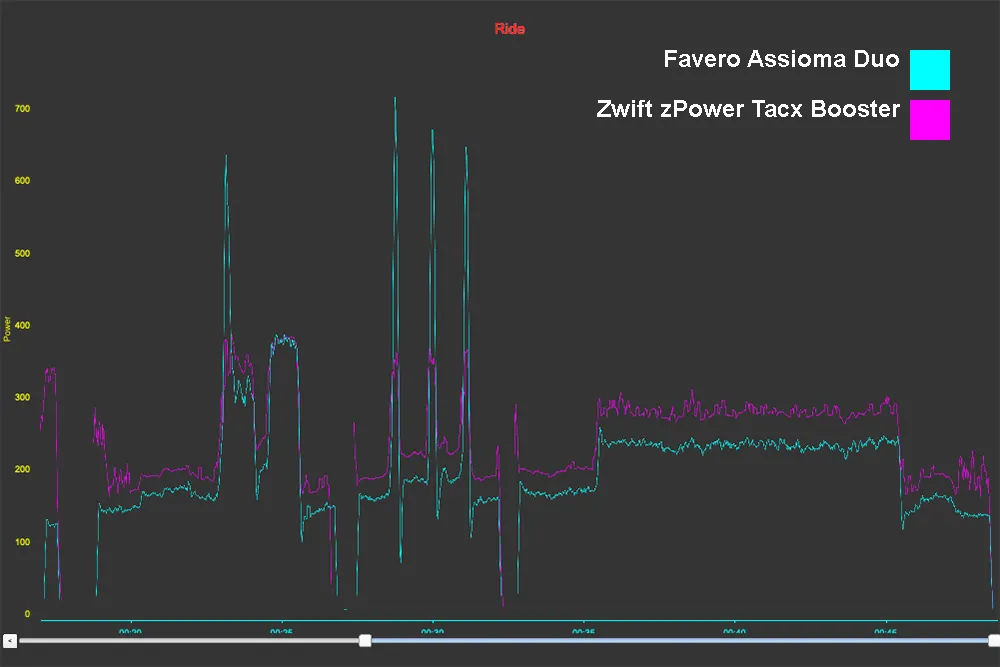
It may be possible to improve the zPower accuracy through careful adjustment of the trainer’s roller resistance and your tyre pressure, but you’ll need a real power meter to compare the numbers against to know whether you’re getting closer or not – and if you have a power meter, just use that.
It’s worth pointing out, though, that this is an issue with practically all non-smart trainers, it’s not just limited to the Tacx Boost.
The key point, however, is that if you want to use Zwift or other training apps, you shouldn’t set your expectations too high with a non-smart trainer, even if it's compatible at a basic level with a speed/cadence sensor.
That’s not an issue for general riding and informal training, particularly if you mainly stick to steady-state efforts, but a low-end smart trainer might be a better option if you’re committed to indoor training or want to race online.
Tacx Boost overall
The Tacx Boost is a relatively affordable classic turbo trainer with very good resistance levels, but it’s noisy at high wattages by modern standards, unstable under load and missing a couple of key accessories out of the box.
Given Tacx’s own Flow wheel-on smart trainer promises full Zwift compatibility out of the box, power accuracy within +/- 5 per cent, simulated gradients up to 6 per cent, and only costs £20 more than the Boost plus speed sensor bundle, the Boost is a hard sell.
If you’re a strong cyclist looking to do high power indoor intervals on a limited budget, who isn’t too interested in interactive indoor cycling apps, then this might be just the ticket (if you have a relatively soundproof space to ride in).
For beginners, or power meter owners looking for a cheap way to do zone-based interval training indoors without having to fork out on a smart trainer, a fluid trainer may provide a more intuitive and possibly quieter indoor cycling experience, at the expense of top-end power capabilities.
Product
| Brand | tacx |
| Price | 349.00 AUD,249.99 EUR,229.99 GBP,299.99 USD |
| Weight | 8.5400, KILOGRAM () - |
Features
| br_mount | wheel_on |
| br_foldingLegs | yes |
| br_trainerType | standard_trainer |
| br_resistanceType | magnetic |
| br_wheelSize | 26in |
| br_wheelSize | 27_5in_650b |
| br_wheelSize | 29in_700c |
| br_maxPower | 1050.0000 |
| br_maxPower | WATT |
| br_flywheelWeight | 1.6500 |
| br_flywheelWeight | KILOGRAM |
| Features | Resistance adjustable over 10 discreet settings via handlebar mounted lever |
| br_dimensions | 675mm x 650mm x 410mm |
| br_hubCompatibility | 5mm rear axles (thru-axle adaptors available seperately) |
